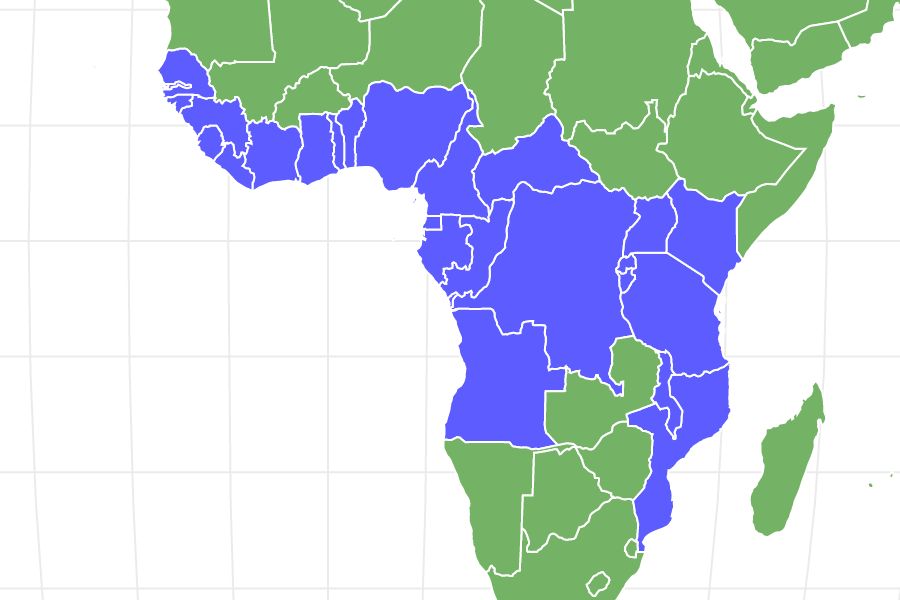Solitary but gathers in groups!
Advertisement
African Palm Civet Scientific Classification
- Kingdom
- Animalia
- Phylum
- Chordata
- Class
- Mammalia
- Order
- Carnivora
- Family
- Nandiniidae
- Genus
- Nandinia
- Scientific Name
- Nandinia binotata
Read our Complete Guide to Classification of Animals.
African Palm Civet Conservation Status
African Palm Civet Facts
- Prey
- Rodents, Snakes, Frogs
- Name Of Young
- Pup
- Group Behavior
- Solitary
- Fun Fact
- Solitary but gathers in groups!
- Estimated Population Size
- Locally abundant
- Biggest Threat
- Habitat loss
- Most Distinctive Feature
- Snout with sharp, pointed teeth
- Other Name(s)
- Two-Spotted Palm Civet
- Gestation Period
- 64 days
- Habitat
- Tropical rainforest
- Predators
- Lions, Snakes, Leopards
- Diet
- Omnivore
- Average Litter Size
- 2
- Lifestyle
- Crepuscular
- Common Name
- African Palm Civet
- Number Of Species
- 1
- Location
- eastern Africa
- Slogan
- Solitary but gathers in groups!
- Group
- Mammal
African Palm Civet Physical Characteristics
- Color
- Brown
- Grey
- Yellow
- Black
- White
- Tan
- Skin Type
- Fur
- Lifespan
- 15 - 20 years
- Weight
- 1.4kg - 4.5kg (3lbs - 10lbs)
- Height
- 43cm - 71cm (17in - 28in)
- Age of Sexual Maturity
- 2 - 3 years
- Age of Weaning
- 2 months
View all of the African Palm Civet images!
Classification And Evolution
The African Palm Civet, also referred to as the Two-Spotted Palm Civet, is a Civet species native to the tropical jungles of eastern and central Africa. The African Palm Civet is in a genetic group of its own, Civettictis civetta, unlike the other Civet species, belonging to the larger group Viverra, which are closely related to each other, making it the most distinctive among the Civet species.
It is believed that the African Civet evolved from the Viverra genus of Civets around 12.3 million years ago, during the Miocene era. It is the last surviving member of its genus.
This mammal is widespread throughout numerous habitats with a large population in certain locations. They are great opportunists and are thought to be the most common forest-dwelling small carnivore in all of Africa.
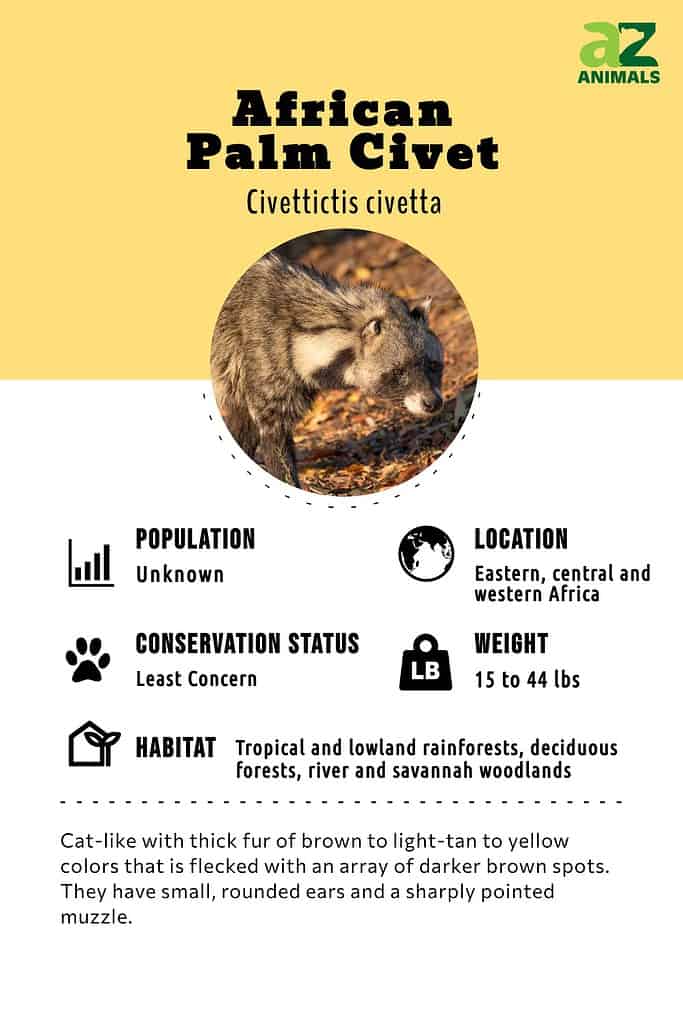
Types Of
The African civet, which is the last surviving member of its genus Civettictis civetta, belongs to a larger family of civets, the group Viverra, of which there are around 19 species, placed in 10 to 12 genera. Here are just a few:
- Malabar large-spotted civet (Viverra civettina)
- Asian palm civet (Paradoxurus hermaphroditus)
- Masked palm civet (Paguma larvata)
- Small Indian civet (Viverricula indica)
- Banded palm civet (Hemigalus derbyanus)
- Large-spotted civet (Viverra megaspila)
- Owston’s palm civet (Chrotogale owstoni)
Anatomy And Appearance
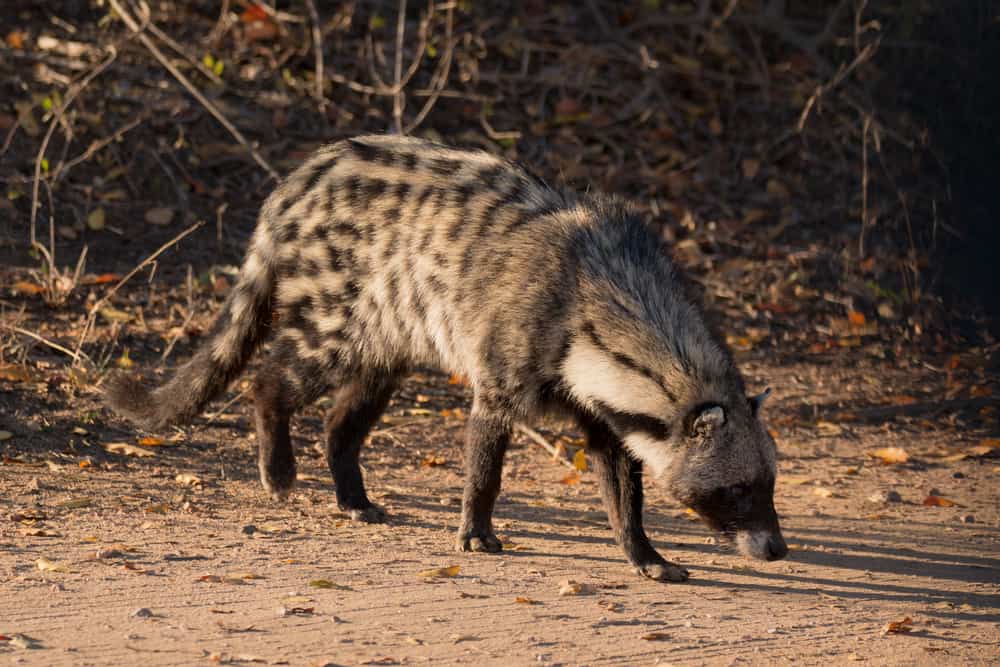
The African Palm Civet is more closely related to the
mongoose
.
©francesco de marco/Shutterstock.com
In spite of their Cat-like appearance and behaviors, these Civets are not felines but rather closely related to other small carnivores including genets, mongooses, and weasels. One of their most characteristic features is their brown to light-tan to yellow colored thick fur, which is flecked with an array of darker brown spots. The fur is darker on the top half of its body and allows the civet to be more easily camouflaged amongst the trees. As with other Civet species, the African Palm Civet has a muzzle that is sharply pointed and has strong, muscular yet comparably short limbs. They have small, rounded ears and yellow-green eyes with slit-shaped pupils.
Distribution And Habitat
The African Palm Civet is generally found inhabiting the tropical jungles and forests across much of eastern Africa and is even found in parts of central and western Africa, where its native habitats still exist. Today its range extends from southern Sudan to Guinea, throughout Angola, and into eastern Zimbabwe. African Palm Civets have proved to be extremely adaptable animals and may also be found in a wide variety of habitats from deciduous forests and lowland rainforests to river and savanna woodlands. The African Palm Civet however is being threatened in much of its natural range due to deforestation causing destruction to or total loss of many of their historical regions.
Behavior And Lifestyle
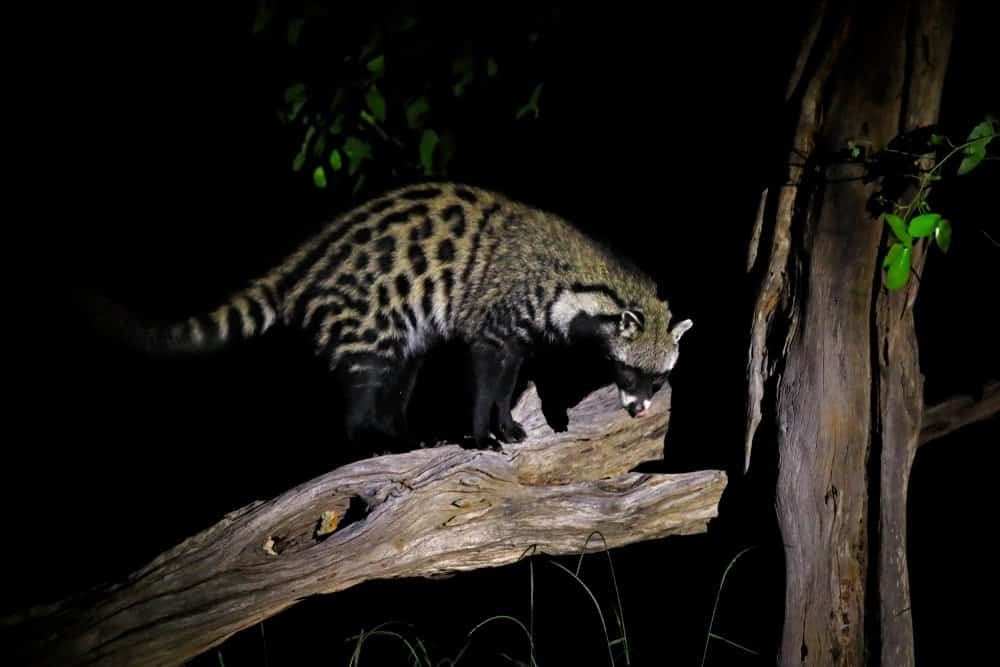
These mammals only emerge for a few hours at dawn and dusk to hunt for food.
©Ondrej Prosicky/Shutterstock.com
A solitary animal that leads a crepuscular lifestyle, the African Palm Civet, only emerges for a few hours at dawn and dusk in order to hunt for food. They are chiefly tree-dwelling animals and much of the day and night is spent resting safely in the shelter of the trees. In spite of being rather solitary animals, when food is in abundance, these mammals have been known to assemble in groups of up to 15 members. African Palm Civets have two sets of scent glands that secret strong-smelling substances. Found between the third and fourth toes on each foot, and on the lower part of their abdomen, these glandular secretions are primarily for marking territories and are involved in mating.
Reproduction And Life Cycles
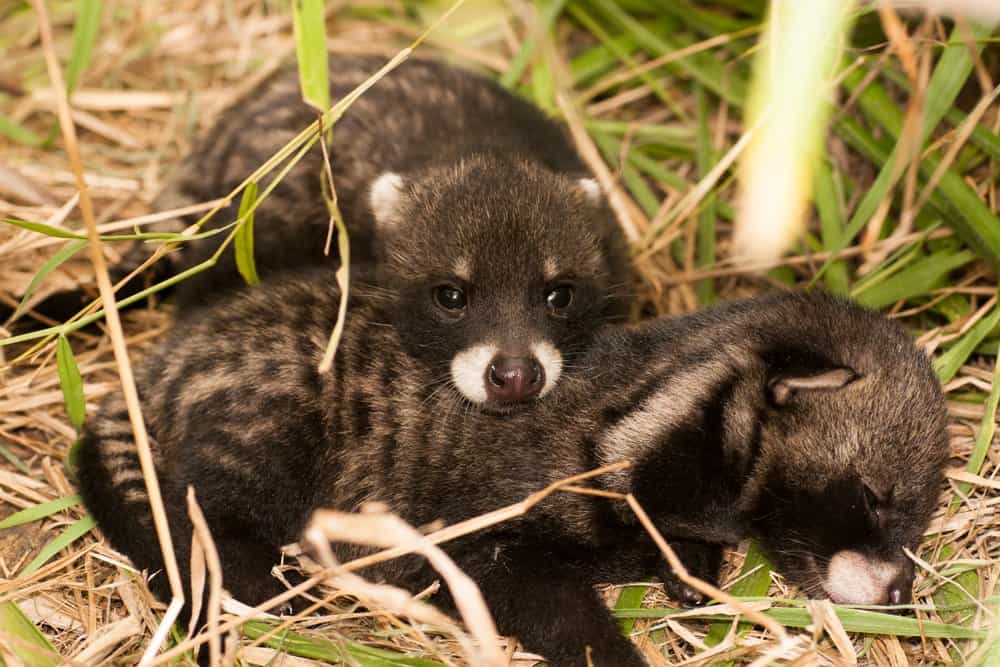
This species is able to breed two times a year during the rainy season when food is more abundant.
©Mark Sheridan-Johnson/Shutterstock.com
African Palm Civets are able to breed twice a year in May and October during the rainy seasons when there is more food available. After a gestation period that lasts for a couple of months, the female African Palm Civet generally gives birth to as many as 4 babies. The young are then weaned by their mother until they are strong enough and able to fend for themselves, which is usually around 60 days old. The female’s mammary glands produce an orange-yellow liquid that stains both her tummy and the baby’s fur the same color. This is thought to discourage males that are either looking for a mate or who want to harm her young. The lifespan of African Palm Civets is usually 15 years old, although it is rare for them to reach this age in the wild.
Diet And Prey
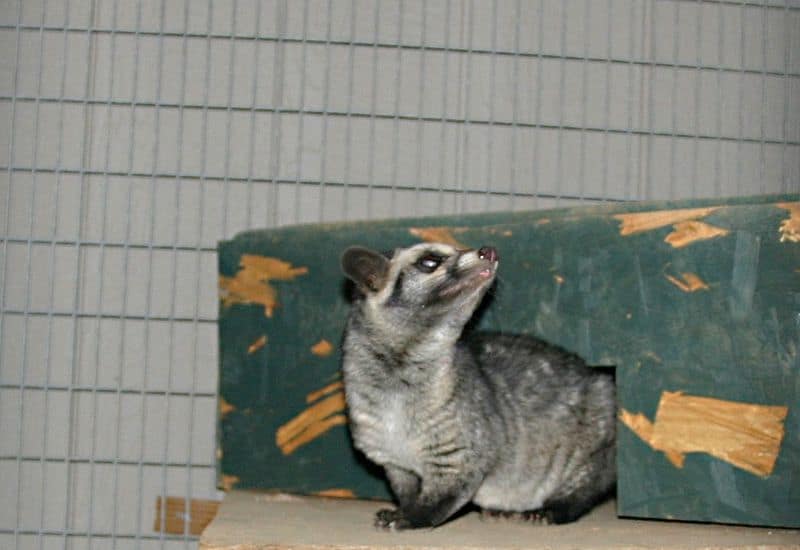
The African Palm Civet, while an omnivorous animal, has a diet comprised mainly of fruits.
©audrey_sel, CC BY-SA 2.0, via Wikimedia Commons – Original / License
An omnivorous animal, the African Palm Civet survives on a diet comprised of both plants and other animals, although pineapples and other fruits still make up the majority of its diet. In addition to insects, small animals such as birds, rodents, frogs, and lizards, are also hunted by the African Palm Civet. African Palm Civets feed by holding their prey in their hands and biting it powerfully a number of times to kill it, before swallowing it whole. The long, sturdy tail is thought to be used as a brace where the Civet is balancing only on its hind legs, and along with the thick-skinned pads on the bottom of its feet, stabilizes the African Palm Civet on the branch while it’s eating.
Predators And Threats
Even though they are a secretive and somewhat ferocious predator, the African Palm Civet is in fact still preyed upon by numerous predators in their natural environment. Although they do spend most of their lives in the trees, African Palm Civets come down to the ground to look for food fairly often, and will even venture outside of the forest if their prey is in short supply. The most common predators of the African Palm Civet are large predatory cats, which include leopards and lions, that are able to hunt the Civet in the trees. Reptiles such as crocodiles and large snakes also hunt the African Palm Civet if given the chance. One of the biggest threats to the African Palm Civet today though is the loss of much of its natural habitat, mainly due to deforestation.
Interesting Facts And Features
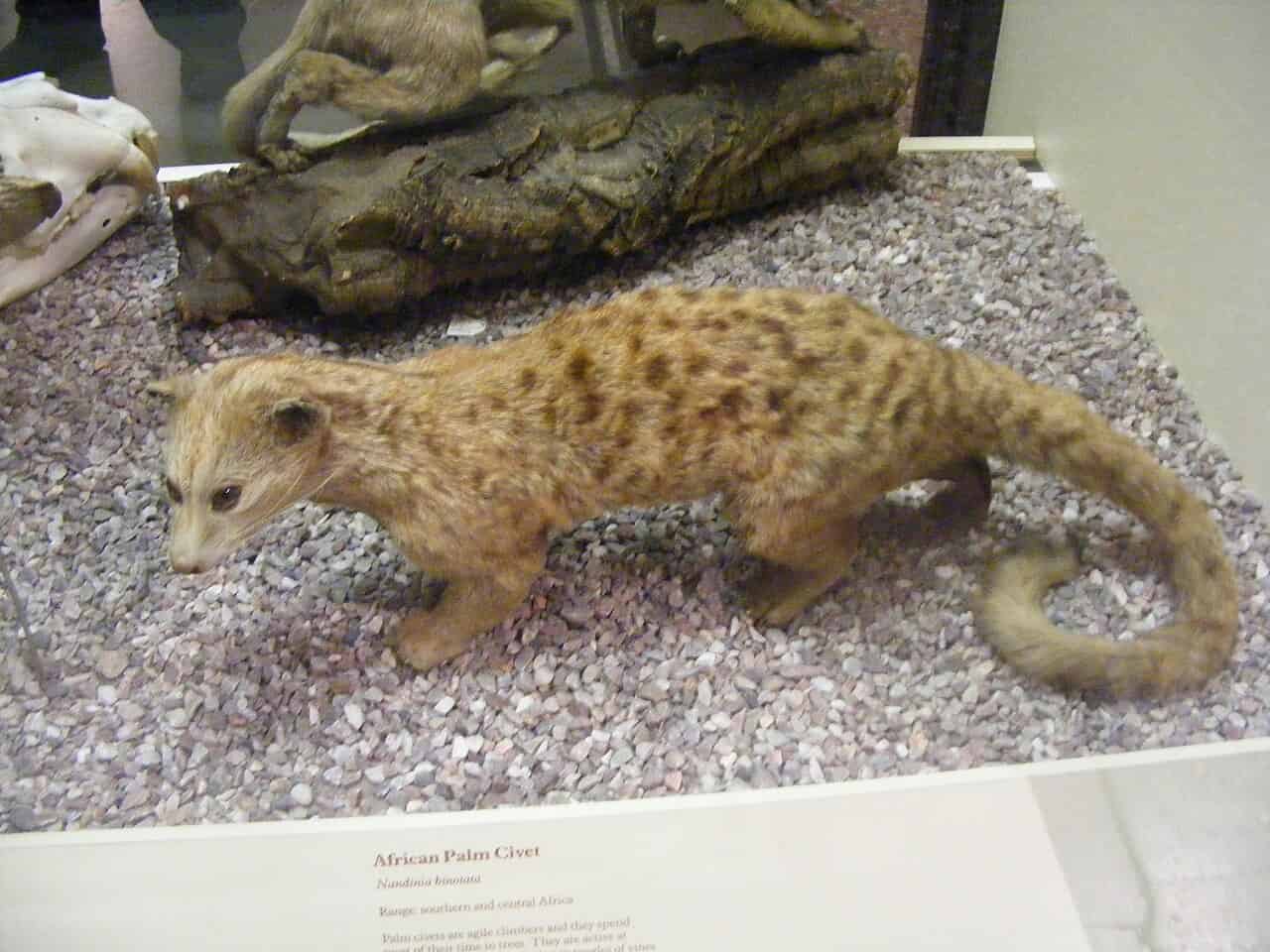
African palm civets were once hunted as bushmeat in certain parts of Africa.
©Subhumanfreak at the English Wikipedia, CC BY-SA 3.0, via Wikimedia Commons – Original / License
The African Palm Civet has a musk by their glands close to their reproductive organs that is secreted that has been collected by humans for hundreds of years. When in its concentrated form, the smell is said to be quite offensive to people, but when diluted, it is much more pleasant. It was this scent that became one of the ingredients in some of the most expensive perfumes in the world. African Palm Civet females are known to produce milk from the exact number of teats as they have young, to ensure that each of their offspring has enough milk to drink and individuals are not so easily excluded during feeding time. Although it is not so common today, African Palm Civets were once commonly hunted as bushmeat in certain parts of the continent.
Relationship With Humans
Farmers that live in the native habitats of the African Palm Civet view these animals very much as pests, as they are commonly known to raid poultry coops in order to get an easy meal. They are extremely persistent and abundant carnivores, which added to their secretiveness, has meant that they have caused great damage to livestock numbers in the past. Humans though have been a bigger threat to the African Palm Civet for years as they were hunted and trapped for their meat, scent, and thick fur coat which is used to make traditional ceremonial garments. The destruction of the African Palm Civet’s natural environment by people is thought to be the biggest threat to the species today.
Conservation Status And Life Today
The African Palm Civet has been listed as an animal that is at lower risk and therefore of Least Concern of becoming extinct in the wild in the immediate future. They are known to be widely distributed, and found in a variety of habitats and population numbers are also in abundance in certain areas. The African Palm Civet is currently under threat from deforestation and has been subjected to the drastic loss of much of its natural habitat. The main reason for such extensive deforestation in these areas is logging and land clearing for plantations used to make palm oil.
View all 194 animals that start with AAfrican Palm Civet FAQs (Frequently Asked Questions)
Are African Palm Civets herbivores, carnivores, or omnivores?
African Palm Civets are Omnivores, meaning they eat both plants and other animals.
What is another name for the African Palm Civet?
The African Palm Civet is also called the two-spotted palm civet.
How to say African Palm Civet in ...
Thank you for reading! Have some feedback for us? Contact the AZ Animals editorial team.
Sources
- David Burnie, Dorling Kindersley (2011) Animal, The Definitive Visual Guide To The World's Wildlife / Accessed August 10, 2010
- Tom Jackson, Lorenz Books (2007) The World Encyclopedia Of Animals / Accessed August 10, 2010
- David Burnie, Kingfisher (2011) The Kingfisher Animal Encyclopedia / Accessed August 10, 2010
- Richard Mackay, University of California Press (2009) The Atlas Of Endangered Species / Accessed August 10, 2010
- David Burnie, Dorling Kindersley (2008) Illustrated Encyclopedia Of Animals / Accessed August 10, 2010
- Dorling Kindersley (2006) Dorling Kindersley Encyclopedia Of Animals / Accessed August 10, 2010
- David W. Macdonald, Oxford University Press (2010) The Encyclopedia Of Mammals / Accessed August 10, 2010
- African Palm Civet Information / Accessed August 10, 2010
- African Palm Civet Diet / Accessed August 10, 2010
- African Palm Civet Appearance / Accessed August 10, 2010
- African Palm Civet Conservation / Accessed August 10, 2010
- African Palm Civet Lifestyle / Accessed August 10, 2010

